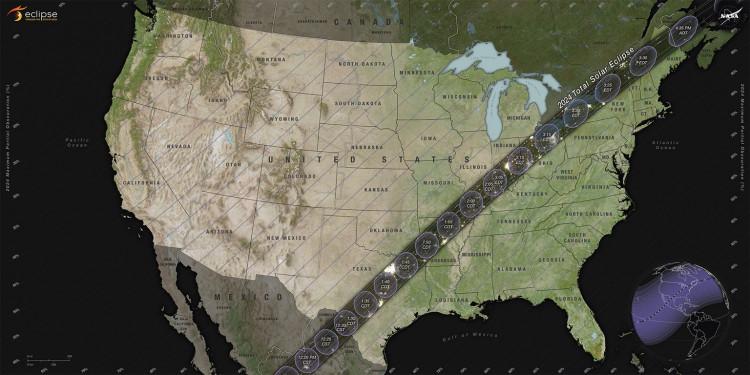On April 8, 2024, millions of people across North America will have the opportunity to witness a once-in-a-lifetime celestial event: a total solar eclipse. This awe-inspiring phenomenon, which occurs when the Moon passes between the Sun and the Earth, blocking out the Sun's face and darkening the sky, promises to be even more spectacular than the "Great American Eclipse" of 2017.
What sets the 2024 total solar eclipse apart from its predecessor is the increased width of the path of totality across the United States. While the 2017 event's path of totality ranged between 62 to 71 miles wide, the upcoming eclipse will span an impressive 108 to 122 miles, allowing a much larger portion of the nation's population to experience the breathtaking moment of totality.
According to experts, an estimated 31.6 million people reside within the path of totality for the 2024 eclipse, more than double the 12 million who had the opportunity in 2017. Even those outside the path of totality will be able to catch a glimpse of at least a partial eclipse, with 150 million people living within 200 miles of the expected totality path.
Another significant difference between the two eclipses is the duration of totality. In 2017, Carbondale, Illinois, experienced the longest totality period at two minutes and 42 seconds. However, the 2024 eclipse will offer an even more extended period of darkness, with the longest totality lasting up to four minutes and 28 seconds in a location roughly 25 minutes northwest of Torreon, Mexico. When the eclipse reaches the center of its path in Texas, the totality period will be around four minutes and 26 seconds, and even as it reaches Canada, it will still last up to three minutes and 21 seconds.
The 2024 total solar eclipse will also be unique due to the Sun's magnetic field being closer to solar maximum, making it more active compared to the 2017 event, which occurred nearer to solar minimum. This heightened activity increases the likelihood of witnessing eruptions from the Sun during the eclipse.
The eclipse will first be experienced in totality across the Pacific coast of Mexico at approximately 11:07 a.m. PDT and will travel through the U.S. before exiting North America at 5:16 p.m. NDT from the Atlantic coast of Newfoundland, Canada. In the United States, totality will begin in Dallas, Texas, at 1:40 p.m. CDT and end in Caribou, Maine, at 3:34 p.m. EDT.
Here are the major cities in each state where you can expect to experience totality:
- Dallas, Texas: 1:40-1:44 p.m. CDT
- Idabel, Oklahoma: 1:45-1:49 p.m. CDT
- Little Rock, Arkansas: 1:51-1:54 p.m. CDT
- Poplar Bluff, Missouri: 1:56-2:00 p.m. CDT
- Paducah, Kentucky: 2-2:02 p.m. CDT
- Carbondale, Illinois: 1:59-2:03 p.m. CDT
- Evansville, Indiana: 2:02-2:05 p.m. CDT
- Cleveland, Ohio: 3:13-3:17 p.m. EDT
- Erie, Pennsylvania: 3:16-3:20 p.m. EDT
- Buffalo, New York: 3:18-3:22 p.m. EDT
- Burlington, Vermont: 3:26-3:29 p.m. EDT
- Lancaster, New Hampshire: 3:27-3:30 p.m. EDT
- Caribou, Maine: 3:32-3:34 p.m. EDT
To safely view the eclipse, it is crucial to wear protective solar viewing glasses or use a handheld solar viewer, ensuring the lens is not scratched, torn, or damaged. Regular sunglasses are not a safe option, as they do not provide adequate protection from the Sun's harmful rays. During the brief period of totality, when the Sun is completely blocked by the Moon, observers can remove their viewing glasses or solar viewers to witness the stunning corona. However, the moment the Sun begins to reappear, the eclipse glasses must be put back on immediately.
For those unable to witness the eclipse in person, various livestream feeds on YouTube will provide coverage of the event, including NASA TV, Exploratorium, Discovery Channel, Slooh, and timeanddate. Special events will also be held across the U.S. for people to watch NASA TV's broadcast, such as the Kerrville Eclipse Festival, the Indianapolis Motor Speedway, the Total Eclipse Fest 2024 in Ohio, and the Southern Illinois Crossroads Eclipse Festival.
After the April 2024 total solar eclipse, the next one visible from the United States will occur on Aug. 12, 2026, passing across northern Spain, Iceland, the Atlantic Ocean, the Arctic, and Greenland.
As North America prepares for this incredible celestial event, the excitement and anticipation are palpable. The 2024 total solar eclipse promises to be an unforgettable experience, offering the longest and widest path of totality in recent U.S. history and providing millions with the chance to witness the awe-inspiring beauty of the cosmos.





